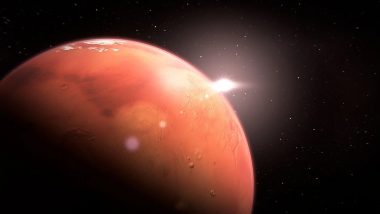The possibility of life on Mars is a huge subject of interest among researchers. Because of its proximity and similarities to Earth and significant studies that found the surface environment of Mars had liquid waters hinted the presence of life in ancient times. Now, a latest study is intensifying that believe even more. Data collected by NASA’s Curiosity rover found that a huge flood once washed over the Gale crater of Mars, about four billion years ago. This leads to the possibility that life may have existed on the red planet. Dubbed as a ‘raging megaflood’ by scientists, the study suggests that it was likely caused by an asteroid or comet hitting the planet, and unleashing ice stored in the Martian surface. Life on Venus Possible? Scientists Discover Traces of Phosphine Gas Coming Out of Aerial Microbes in Venusian Atmosphere.
The joint project was conducted by scientists from Jackson State University, Cornell University, the Jet Propulsion Laboratory and the University of Hawaii. And the results have been published in the journal Nature Scientific Reports, including photographs of the crater. The study shows that the megaflood might have resulted from the meltdown of icy reservoirs on the planet due to the heat of a meteoritic impact. The impact was so huge that the ‘gigantic ripples’ left geological footprints on the surface of the red planet. Just like it happens on Earth, these geographical structures have remained intact after billions of years.
“We identified megafloods for the first time using detailed sedimentological data observed by the rover Curiosity,” co-author Alberto G. Fairén stated in the study. He added, “Deposits left behind by megafloods had not been previously identified with orbiter data.” The antidunes seen in data from NASA’s Curiosity are similar to the features formed by melting ice on Earth, about two million years ago, co-author, Ezat Heydari, explained.
The study went on explaining that the megafloods could be the result of the melting of ice from heat generated by a large impact that released carbon dioxide and methane from frozen reservoirs. Conditions must have been ‘warm and wet’ on our neighbouring world for a short time thereafter. After the condensation formed water vapour clouds, creating torrential rains, entered Gale Crater and joined the water coming from Mount Sharp in the crater, producing flash floods.
NASA’s Curiosity Rover has already proven that lakes and streams were once a reality in Mars, as per earlier studies. It did have all the conditions needed to support the presence of liquid water on the surface, which in turn indicated the presence of life. The latest findings add more to the theory.
(The above story first appeared on LatestLY on Nov 24, 2020 04:57 PM IST. For more news and updates on politics, world, sports, entertainment and lifestyle, log on to our website latestly.com).













 Quickly
Quickly











